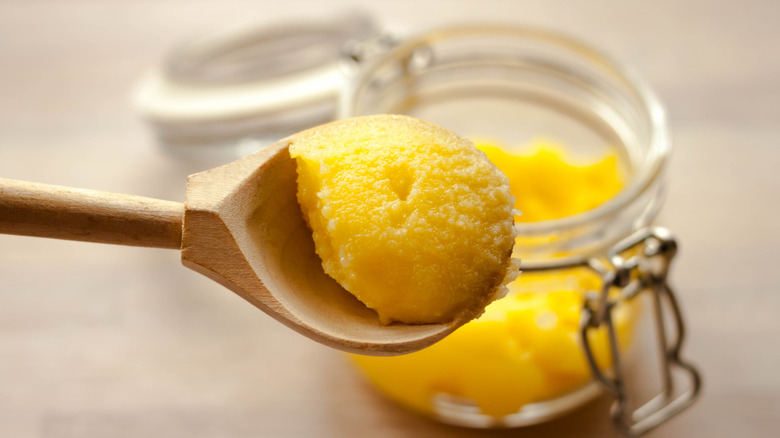What's The Main Difference Between Traditional And Modern Ghee?
Ghee has been around for centuries, earning its reputation as a culinary and cultural staple in South Asian cooking. But what is it exactly? Ghee is delicious clarified butter which means it's been cooked to remove water and milk solids, leaving behind pure golden fat with a nutty, aromatic flavor. No wonder clarified butter is so tasty. It's that buttery essence that gives dishes like dal, parathas, and even butter chicken their rich and irresistible taste. Whether you're slathering it on naan or swirling it into rice, ghee is more than just butter's sophisticated cousin — it's a flavor powerhouse and it should certainly make it onto your list of butters you ought to buy.
While ghee has been made traditionally for generations, modern innovations have taken this time-honored ingredient in new directions. Traditional ghee is an art form, often made in small batches at home, while modern ghee typically comes from a jar on a supermarket shelf. But don't be fooled by the packaging — there are some key differences between the two.
Traditional ghee vs. modern ghee
Traditional ghee, or desi ghee, has deep cultural and culinary roots. Typically made from scratch at home, it starts with whole milk which is churned into yogurt, then butter, and finally cooked down into ghee. The process is meticulous, rooted in tradition, and results in a ghee with a robust flavor profile and aroma. It's often prized for its rich nuttiness, which comes from the caramelization of milk solids during the cooking process. Traditional ghee also boasts a higher concentration of nutrients like fat-soluble vitamins, omega-3s, and conjugated linoleic acid, as it's typically made from grass-fed cow's milk.
Modern ghee, on the other hand, is designed for convenience. Found on store shelves, it skips the labor-intensive steps of yogurt churning and is often made directly from butter. While still a fantastic ingredient, it's usually mass-produced, which can mean a milder flavor and sometimes the use of non-grass-fed milk. However, modern ghee often comes fortified or infused with flavors, appealing to today's adventurous cooks. Whether you're sautéing veggies, whipping up an Instant Pot butter chicken, or experimenting with fusion recipes, modern ghee fits right into the mix.
Despite the differences, both versions have their place in the kitchen. Traditional ghee is perfect for those wanting an authentic, from-the-earth experience, while modern ghee offers a practical solution for busy home cooks. Either way, ghee is the gift that keeps on giving — making even the simplest dishes taste decadent.

